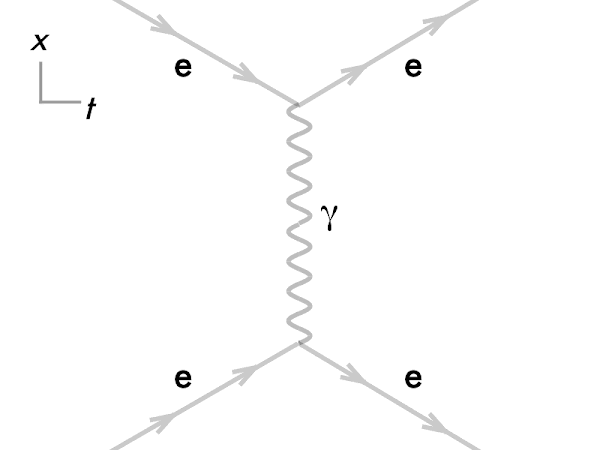Cuesta College, San Luis Obispo, CA
Students have a weekly online reading assignment (hosted by SurveyMonkey.com), where they answer questions based on reading their textbook, material covered in previous lectures, opinion questions, and/or asking (anonymous) questions or making (anonymous) comments. Full credit is given for completing the online reading assignment before next week's lecture, regardless if whether their answers are correct/incorrect. Selected results/questions/comments are addressed by the instructor at the start of the following lecture.
The following questions were asked on reading presentations Feynman diagrams (Phillip "Flip" Tanedo, Cornell University/USLHC Collaboration) and quantum electrodynamics (QED) (Christopher "Bot" Skilbeck, cronodon.com).

Ralph Leighton
symmetrymagazine.org/article/may-2014/saving-the-feynman-van
Selected/edited responses are given below.
Describe what you understand from the assigned textbook reading or presentation preview. Your description (2-3 sentences) should specifically demonstrate your level of understanding.
"Well I understand now from the reading that when electrons come closer together, they will repel (knew this already), the virtual photon that is exchanged is the physical result of the repelling of forces (what I did not know) between electrons. This is what Yukawa discovered which developed into his quantum field theory after he determined that the neutron-proton interaction within an atomic nucleus diminishes rapidly for distances greater than about 2 fm (femtometer, 1 fm = 10−15 m). This actually helps paint the picture as to the decrease in energy of a particle within a nucleus as it travels through subsequent orbitals away from the nucleus (If I remember my chemistry correctly). Thanks, physics!"
"A system creates a highly energetic virtual particle, then that particle is shorter-lived, and since no such particle is assumed to travel faster than light, this means that the particle can not travel as far before it disappears and so the force has a shorter range."
"From what I understand of this section (which is not much) I understand the different types of elementary particles. I also understand the logic of the Feynman diagrams, I'm just not too sure I understand them at the moment."
"Quantum Electrodynamics is the theory of the electromagnetic interaction; the interaction between electrically charged particles "mediated by photons.'"
"Basically these diagrams require an in and an out. They aren't valid if the arrows are both pointing in or both out. You read them from left to right and that determines whether or not they're absorbing energy or releasing it."
"I understand that time traveling from left to right, it’s just that the photon-exchange occurs in the middle and can proceed in either direction. I also understand that the first-order processes dominate and the higher-order processes can usually be ignored, though some of them produce important physical effects and they may become more important at very high energies."
"I understand about as much as I did after the last lesson. I follow the lines and the squiggles, and that is what I understand so far."
Describe what you found confusing from the assigned textbook reading or presentation preview. Your description (2-3 sentences) should specifically identify the concept(s) that you do not understand.
"Feynman diagrams are just too much!!"
"For some reason it is hard for me sometimes to determine the charge of the interaction particle."
"I was confused as to why I did better on the midterm than I thought I was going to do."
"I do not understand how a positron mathematically can represent a electron particle going back in time, like I understand as how one can just say that but they don't 'really' mean it. However, I am having trouble as to determining what would make someone say that? My head is certainly not wrapping itself around this whole nuclear physics thing, first time reading this I was thinking, "Can subatomic particles actually move back in time?'"
"I have a hard time figuring out what the whole picture means--when the symbols are put together from the individual squiggles."
"I probably find everything to be confusing. I'm catching up though and from what I've heard, this stuff isn't that bad. I'll okay."

negative. ******* [7] zero. ******* [17] positive. ******** [8] (Unsure/guessing/lost/help!) ***** [5]

negative. ******* [7] zero. **** [4] positive. ************* [18] (Unsure/guessing/lost/help!) ******** [8]

negative. ***** [5] zero. ************ [12] positive. ********** [10] (Unsure/guessing/lost/help!) ********** [10]
Ask the instructor an anonymous question, or make a comment. Selected questions/comments may be discussed in class.
"I met the coolest Golden Retriever today. His name was Tully, and I have been granted permission to hangout with him one-on-one this Friday. P-dog, you're invited too, come if you want! Also, I am taking pride in this comment, so...MY NAME IS __________ AND I'M HANGING OUT WITH A GOLDEN RETRIEVER THIS FRIDAY AND YOU AREN'T."
"LAST WEEK OF CLASSES!!!!! WE ARE ALMOST THERE!!!! JUST KEEP PUSHNG GUYS!!!"
"REVIEW!!!"
"I'm going to miss coming to physics."
"Will this stuff be on the final?" (Yes--refer to the study guide. But survive Quiz 7, first.)
"I AM SO LOST. How do you know if a Feynman diagram shows annihilation, pair production, photon emission or absorption? And now we are throwing negative, positive, and neutral charges in the mix! :O I need clarification. :O" (Feynman diagram emoji: >~~~~<)
No comments:
Post a Comment